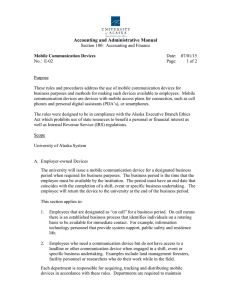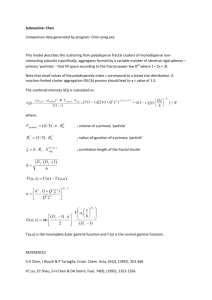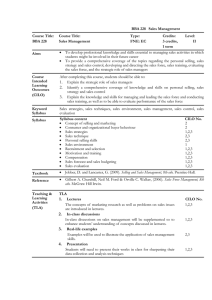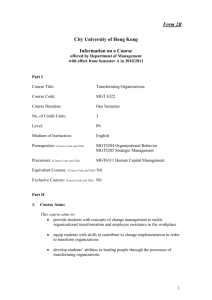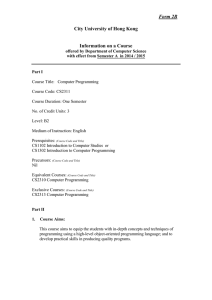w - arXiv.org
advertisement
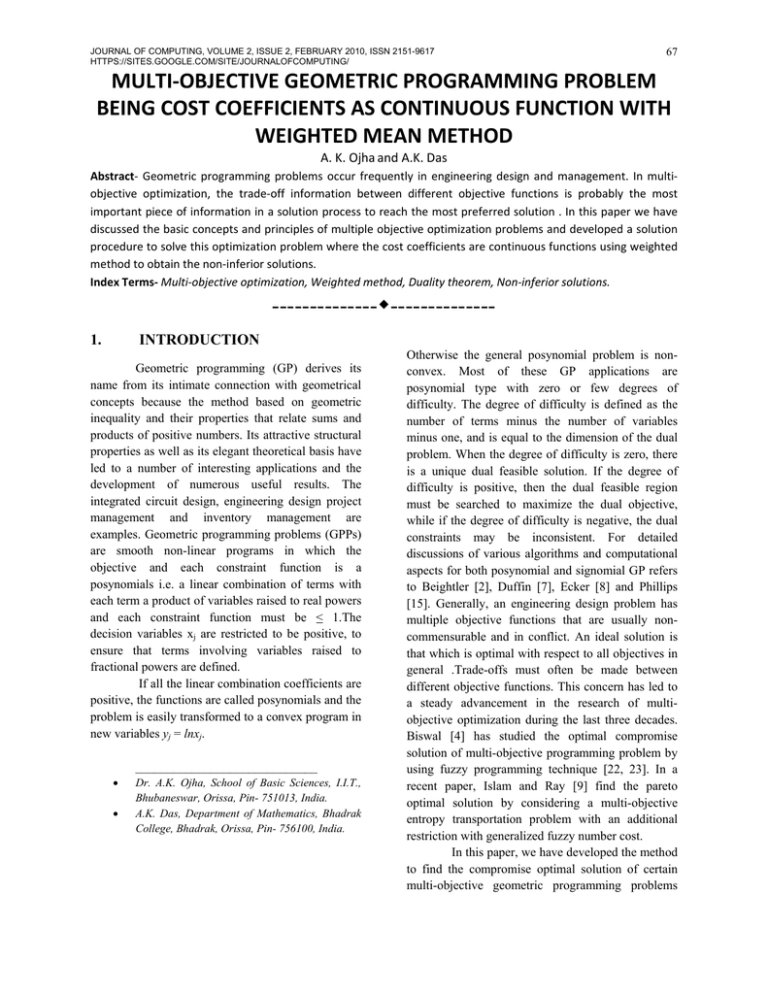
JOURNAL OF COMPUTING, VOLUME 2, ISSUE 2, FEBRUARY 2010, ISSN 2151-9617
HTTPS://SITES.GOOGLE.COM/SITE/JOURNALOFCOMPUTING/ 67
MULTI‐OBJECTIVE GEOMETRIC PROGRAMMING PROBLEM BEING COST COEFFICIENTS AS CONTINUOUS FUNCTION WITH WEIGHTED MEAN METHOD A. K. Ojha and A.K. Das Abstract‐ Geometric programming problems occur frequently in engineering design and management. In multi‐
objective optimization, the trade‐off information between different objective functions is probably the most important piece of information in a solution process to reach the most preferred solution . In this paper we have discussed the basic concepts and principles of multiple objective optimization problems and developed a solution procedure to solve this optimization problem where the cost coefficients are continuous functions using weighted method to obtain the non‐inferior solutions. Index Terms‐ Multi‐objective optimization, Weighted method, Duality theorem, Non‐inferior solutions. ---------------------------1.
INTRODUCTION
Geometric programming (GP) derives its
name from its intimate connection with geometrical
concepts because the method based on geometric
inequality and their properties that relate sums and
products of positive numbers. Its attractive structural
properties as well as its elegant theoretical basis have
led to a number of interesting applications and the
development of numerous useful results. The
integrated circuit design, engineering design project
management and inventory management are
examples. Geometric programming problems (GPPs)
are smooth non-linear programs in which the
objective and each constraint function is a
posynomials i.e. a linear combination of terms with
each term a product of variables raised to real powers
and each constraint function must be < 1.The
decision variables xj are restricted to be positive, to
ensure that terms involving variables raised to
fractional powers are defined.
If all the linear combination coefficients are
positive, the functions are called posynomials and the
problem is easily transformed to a convex program in
new variables yj = lnxj.
_____________________________
Dr. A.K. Ojha, School of Basic Sciences, I.I.T.,
Bhubaneswar, Orissa, Pin- 751013, India.
A.K. Das, Department of Mathematics, Bhadrak
College, Bhadrak, Orissa, Pin- 756100, India.
Otherwise the general posynomial problem is nonconvex. Most of these GP applications are
posynomial type with zero or few degrees of
difficulty. The degree of difficulty is defined as the
number of terms minus the number of variables
minus one, and is equal to the dimension of the dual
problem. When the degree of difficulty is zero, there
is a unique dual feasible solution. If the degree of
difficulty is positive, then the dual feasible region
must be searched to maximize the dual objective,
while if the degree of difficulty is negative, the dual
constraints may be inconsistent. For detailed
discussions of various algorithms and computational
aspects for both posynomial and signomial GP refers
to Beightler [2], Duffin [7], Ecker [8] and Phillips
[15]. Generally, an engineering design problem has
multiple objective functions that are usually noncommensurable and in conflict. An ideal solution is
that which is optimal with respect to all objectives in
general .Trade-offs must often be made between
different objective functions. This concern has led to
a steady advancement in the research of multiobjective optimization during the last three decades.
Biswal [4] has studied the optimal compromise
solution of multi-objective programming problem by
using fuzzy programming technique [22, 23]. In a
recent paper, Islam and Ray [9] find the pareto
optimal solution by considering a multi-objective
entropy transportation problem with an additional
restriction with generalized fuzzy number cost.
In this paper, we have developed the method
to find the compromise optimal solution of certain
multi-objective geometric programming problems
68
JOURNAL OF COMPUTING, VOLUME 2, ISSUE 2, FEBRUARY 2010, ISSN 2151-9617
HTTPS://SITES.GOOGLE.COM/SITE/JOURNALOFCOMPUTING/ where the cost coefficients are continuous functions
by using weighting method. First of all, the multiple
objective functions transformed to a single objective
by considering it as the linear combination of the
multiple objectives along with suitable constants
called weights. By changing the weights, the most
compromise optimal solution has been arrived by
using GP techniques.
The organization of the paper is as follows:
following the introduction, formulation of multiobjective GP and corresponding weighting method
have been discussed in section-2 and 3. The duality
theory has been discussed in section-4 to find the
optimal value of the objective function and the
illustrative examples have been incorporated in
section-5 to understand the problem. Finally, in
section-6 some conclusions are drawn from the
discussion.
2 Formulation of Multi­objective Geometric Programming Find x = (x1, x2,…..xn)T
so as to
T k0
n
f x g C xa
k0
k
t 1
k 0t
j 1
k 0 tj
j
k= 1,2,……..,p
(2.1)
subject to
Ti
n
f x C xa
i
t 1
it
j 1
j
itj
1, i 1,2,...., m
xj > 0 , j = 1,2,…….,n
Let
n
W {w : w R,
k
n
0, wk 1}
k 1
be the set of non-negative weights. Using weighting
method the above multi-objective function can be
defined as:
min p
(3.1)
Q w
f x
x X k 1 wk k 0
subject to
fi(x) < 1; i = 1, 2, ……,m
(3.2)
(2.2)
(2.3)
p
min
: Z x wk
x
k 1
f x
k0
p
T k0
wk ( g
Tk0 = number of terms present in the kth objective
k 1
p T k0
=
function.
Ti= number of terms present in the i constraint.
th
In the above multi-objective geometric program there
are p number of minimization type objective
function, m number of inequality type constraints and
n number of strictly positive decision variables.
(3.3)
It must be made clear, however, that if the
objective space of the original problem is nonconvex, then the weighting method may not be
capable of generating the efficient solutions on the
non-convex part of the efficient frontier. It must also
be noted that the optimal solution of a weighting
problem should not be used as the best compromise
solution, if the weights do not reflect the decision
maker's preferences or if the decision maker does not
accept the assumption of a linear utility function. For
more details about the weighted method refer[13].
Based on the importance of the p number of
objective functions defined in(2.1) the weights w1,w2,
……..,wp are assigned to define a new min type
objective function Z(x) which can be defined as
Where Ck0t for all k and t are positive real numbers
and aitj and ak0tj are real numbers for all i, k, t, j.
gk are continuous functions for all k.
3 Weighting Method of Multi­objective Functions w
xj > 0; j = 1, 2, ………..,n
A multi-objective geometric programming problem
can be defined as:
min :
The weighting method is the simplest multi-objective
optimization which has been widely applied to find
the non-inferior optimal solution of multi-objective
function within the convex objective space.
If f10(x), f20(x),……,fp0(x) are p objective functions
for any vector x = (x1, x2…. xn)T
then we can define weighting method for their
optimal solution as defined below:
k 1 t 1
x
j
t 1
n
k
C xa
k 0t
k 0 tj
j
j 1
)
n
w g C xa
k
k
k 0t
j 1
0, j 1,2,...., n
j
kotj
(3.4)
(3.5)
where
p
w
k 1
k
1, wk 0, k 1,2,......, p
(3.6)
69
JOURNAL OF COMPUTING, VOLUME 2, ISSUE 2, FEBRUARY 2010, ISSN 2151-9617
HTTPS://SITES.GOOGLE.COM/SITE/JOURNALOFCOMPUTING/ 4 Dual Form of GPP The model given by (3.4), (3.5) and (3.6) is
a conventional geometric programming problem and
it can be solved directly by using primal based
algorithm for non linear primal problem or dual
programming [14]. Methods due to Rajgopal and
Bricker [17], Beightler and Phillips[1] and Duffin et
al.[6] projected in their analysis that the dual problem
has the desirable features of being linearly
constrained and having an objective function with
structural properties with suitable solution.
According to Duffin et al.[6] the model
given by (3.5) can be transformed to the
corresponding dual geometric program as:
w0 t
wit
m Ti
max T k 0 wk g k C k 0t
w
i0
:
w t 1
w0t i1 t 1 wit
wit
w
it
subject to
(1/3)x12x2-2+ (4/3)x21/2x3-1 <1
x1, x2, x3 > 0
where
w1 + w2 = 1, w1,w2 > 0
g(t) = 2t + 2
h(t) = t + 1
This problem is having a certain degree of
Duffin [7]
The corresponding dual program is:
w01
max
w
t 1
p
T k0
0t
w04
40 w2
w04
m
k 1 t 1
0t
itj
it
p
k 1
k
w12
w03
20
w1
w03
w11
13
w
11
w12
43
w
12
(5.9)
0, j 1,2,...., n
wit 0t , i
w
w05
h w2
w05
11
Ti
i 1 t 1
w02
20
w1
w02
w11 w12w
1
a w a w
k 0 tj
g w1
w01
: V w
(4.1)
w
(5.6)
(5.7)
(5.8)
difficulty
3. The problem is solved via the dual programming
subject to
T k0
(5.5)
1, wk 0, k 1,2,......, p
Since it is usually a dual problem then it can be
solved using a method relating
to the dual theory.
5 Numerical Examples For illustration we consider the following examples.
Example:1 Find x1, x2, x3 so as to
(5.1)
min : f1(x) = gx1-1 x2-1/2 x3-1+20x1x3 +20x1x2x3
-1 -1 -1
1/3 3/4
min : f2(x) = 40x1 x2 x3 + hx1 x3
subject to
(5.3)
x1-2x2-2+4x21/2x33/4<3
x1, x2, x3 > 0
In this example we have considered some cost
coefficients in two objectives as continuous
functions.
Introducing weights for the above objective functions
a new objective function is formulated as:
Z(x) = w1(gx1-1x2-1/2x3-1+20x1x3+20x1x2x3)
+ w2(40x1-1x2-1x3-1+hx11/3x33/4) (5.4)
subject to
w01 + w02 + w03 + w04 + w05 = 1
-w01 + w02 + w03 - w04 + (1/3)w05- 2w11 = 0
-(1/2)w01 + w03 -w04- 2w11 + (1/2)w12 = 0
-w01 + w02 + w03- w04 + (3/4)w05 - w12 = 0
w1 + w2 = 1
w01,w02,w03,w04,w05,w11,w12 >0
w1,w2 > 0
By considering different values of w1 ,w2 ,g, h and
the dual variables, corresponding maximum value of
dual objective is given in the following table.
Table-1(a)
Dual Solution [g=40,h=20]
w1
w2
w01
w02
w03
.1
.9
.3538166E-01
.4491953E-01
.1629705
.2
.8
.6460256E-01
.9304868E-01
.2224467
.3
.7
.8981589E-01
.1386930
.2615291
.4
.6
.1117080
.1822681
.2912977
.5
.5
.1308674
.2238612
.3157730
Table-1(b)
Dual Solution[g=40,h=20
w04
w05
w11
w12
Z
.1671291
.5895484
.1009222
.4474897
51.40669
.1671291
.4527729
.1173440
.4233434
58.67673
.1526150
.3573470
.1384534
.4258014
64.87778
.1325447
.2821815
.1616868
.4409492
70.51816
.1101877
.2193107
.1858413
.4630621
75.81600
70
JOURNAL OF COMPUTING, VOLUME 2, ISSUE 2, FEBRUARY 2010, ISSN 2151-9617
HTTPS://SITES.GOOGLE.COM/SITE/JOURNALOFCOMPUTING/ Table-2(a)
Dual Solution [g=42,h=21]
Table-5
Primal Solution[g=42,h=21]
w1
w2
w01
w02
w03
.1
.9
.3595181E-01
.4399913E-01
.1570954
w1
w2
x2
x3
Z
0.9
0.3783509
3.570412
3.082458
53.01235
x1
.2
.8
.6595986E - 01
.9141579E -01
.2162172
0.1
.3
.7
.9206252E -01
..1364239
.2553973
0.2
0.8
0.5268679
2.365203
2.611029
60.19380
.2853658
0.3
0.7
0.6260859
1.872084
2.408787
66.32737
.3100875
0.4
0.6
0.7042765
1.590465
2.289866
71.90609
0.5
0.5
0.7703444
1.406016
2.208535
77.14276
.4
.6
.5
.1148757
.5
.1794227
.1349398
.2205432
Table-2(b)
Dual Solution [g=42,h=21]
Table-6
Primal Solution [g=44, h=22]
w04
w05
w11
w12
Z
.1630853
.5998684
.1010068
.4519587
53.01235
.1633865
.4630206
.1163134
.4255522
60.19380
.1495228
.3665935
.1362168
.4251809
66.32737
.1301272
.2902086
.1582609
.4374420
71.90609
.1083816
.2260479
.1813293
.4568453
77.14276
Table-3(a)
Dual Solution[g=44,h=22]
w1
w2
w01
w02
w03
.1
.9
.2
.8
.364869E - 01
.431282E - 01
.1515729
.672419E -01
.898600E - 01
.2102984
.3
.7
.941988E - 01
.1342586
.2495379
.4
.6
.1179082
.1766990
.2796733
.5
.5
.1388617
.2173522
.3046089
Table-3(b)
Dual Solution [g=44,h=22]
w04
w05
w11
w12
Z
.1592421
.6095698
.1010810
.4561494
54.61683
.1598354
.47276742
.1153346
.4276542
61.70927
.1465658
.3754388
.1340890
.4246109
67.77508
.1278009
.2979186
.1549847
.4341022
73.29226
.1066352
.2325419
.1769891
.4508707
78.46815
Using primal dual relationship the corresponding
primal solution are given in the following table.
Table-4
Primal Solution[g=40,h=20]
w1
w2
x1
x2
x3
Z
0.1
0.9
0.3709596
3.628046
3.112426
51.40669
0.2
0.8
0.5184022
2.390645
2.632994
58.67673
0.3
0.7
0.6181019
1.885667
2.426272
64.87778
0.4
0.6
0.6974348
1.598181
2.303659
70.51816
0.5
0.5
0.7648254
1.410574
2.219104
75.81600
w1
0.1
0.2
0.3
0.4
0.5
w2
0.9
0.8
0.7
0.6
0.5
x1
0.3857122
0.5352863
0.6340715
0.7111610
0.7759240
x2
3.514460
2.340286
1.858634
1.582766
1.401452
x3
3.053485
2.589830
2.391791
2.276326
2.198055
Z
54.61683
61.70927
67.77508
73.29226
78.46815
Example:2
Find x1, x2, x3, x4 so as to
min : f1(x) = gx1x22 x3-1 + 2x1-1 x2-3x4+10x1x3 (5.10)
(5.11)
min : f2(x) = x1-2 x2-1 x3 x4-1 + hx1-3 x22 x3-2
subject to
(5.12)
3x1-1x3x4-2+ 4x3x4 < 1
(5.13)
kx1x2 < 1
(5.14)
x1, x2, x3, x4 > 0
In this example we have considered some cost
coefficients in two objectives are continuous
functions and one constraint coefficient is continuous
function. Using the weights the above objective
function can be reduced to the new objective function
as:
Z(x) = w1(gx1x22 x3-1+2x1-1x2-3+10x1x3)
+w2(x12x2-1x3x4 -1+hx1-3x22 x3-2)
subject to
3x1-1x3x4-2+ 4x3x4 < 1
(5.17)
kx1x2 < 1
x1, x2, x3 > 0
where
(5.15)
(5.16)
(5.18)
(5.19)
g(t) = t2
h(t) = t + 1
(5.20)
k(t) = 2t + 3
(5.21)
(5.22)
w1 + w2 = 1, w1,w2 > 0
In this problem the degree of difficulty is 3 and it can
be solved by using duality theory as given by
71
JOURNAL OF COMPUTING, VOLUME 2, ISSUE 2, FEBRUARY 2010, ISSN 2151-9617
HTTPS://SITES.GOOGLE.COM/SITE/JOURNALOFCOMPUTING/ w1
w2
.1
.9
.2
.8
.3
.7
.4
.6
.5
.5
w01
.2583442
E-02
.3764835
E-02
.4753309
E-02
.5718845
E-02
.6754852
E-02
w02 .7428173
.7584524
.7629485
.7646817
.7653131
w01
max
: V w
w
g w1
w
01
w2
w04
w04
h
w2
w05
w03 .1483374
E-02
.1511017
E-02
.1538947
E-02
.1566427
E-02
.1594399
E-02
w02
2 w1
w
02
w05
w11
3
w11
w04
.2118867
E-01
.8334759
E-02
.4322214
E-02
.2491526
E-02
.1493452
E-02
w03
10 w1
w
03
w12
4 w
k
w12
w11 w12w
w12
subject to
w01 + w02 + w03 + w04 + w05 = 1
w01- w02 + w03 + 2w04- 3w05- w11 + w21 = 0
2w01 -3w02 - w03 + 2w04 + w21 = 0
-w01 + w03 + w04-2w05 + w11 + w12 = 0
w02- w04- 2w11 + w12 = 0
w01,w02,w03,w04,w05,w11,w12,w21≥ 0
w1 + w2 = 1
w1,w2 > 0
For different values of w1,w2, g, h and the dual
variables; the corresponding maximum values of dual
objectives are obtained as given in the tables
Table‐1(a) Dual Solution [g=1,h=2,k=5]
w2
.1
.9
.2
.8
.3
.7
.4
.6
.5
.5
w01
.1883184
E-02
.2875885
E-02
.3709217
E-02
.4515186
E-02
.5731889
E-02
w02
.7066979
.7404825
.7521911
.7576144
.7604136
w03
.3912119
E-02
.3957753
E-02
.3999773
E-02
.4050324
E-02
.4108534
E-02
w04
.4807176
E-01
.2103163
E-01
.1141363
E-01
.6740309
E-02
.4099518
E-02
Table-1(b)
Dual Solution [g=1,h=2,k=5]
w05
w11
.2394350
.3624652
.2316522
.3868806
.2286863
.3954820
.2270798
.3995861
w12
.6630413
E-01
.5431305
E-01
.5018649
E-01
.4829802
.4018303
w21
Z
1.685529
23.30086
1.773423
37.49259
1.803196
49.25933
1.816394
59.15666
E-01
.4734644
E-01
1.822584
67.31155
Table-2(a)
Dual Solution [g=4,h=3,k=7]
Table-2(b)
Dual Solution [g=4,h=3,k=7]
w05
w11
.2319272
.3884648
.2279370
.3999702
.2264370
.4034642
.2255415
.4049780
.2248442
.4057250
w12
.5530093
E-01
.4982283
E-01
.4830204
E-01
.4776588
E-01
.4763040
E-01
w21 Z
1.780619
46.15296
1.820288
75.76130
1.830787
100.2160
1.834016
120.7471
1.834235
137.6543
Table-3(a)
Dual Solution [g=9,h=4,k=9]
21
11
w1
.2260064
w1
w2
.1
.9
.2
.8
.3
.7
.4
.6
.5
.5
w01
.2556200
E-02
.3643589
E-02
.4564563
E-02
.5471832
E-02
.6450544
E-02
w02 .7569191
.7647673
.7667072
.7672706
.7672784
w03 .7197187
E-03
.7388184
E-03
.7551118
E-03
.7699552
E-03
.7844841
E-03
w04
.1069413
E-01
.4008480
E-02
.2044494
E-02
.1169431
E-02
.6980240
E-03
Table-3(b)
Dual Solution [g=9,h=4,k=9]
w05
w11
.2291109
.3985297
.2268418
.4044462
.2259287
.4060950
.2253182
.4067567
.2247886
.4070418
w12
.5083442
E-01
.4813366
E-01
.4752731
E-01
.4741216
E-01
.4750335
E-01
w21 Z
1.818117
77.71193
1.837340
128.4884
1.841180
170.3272
1.841401
205.4137
1.840055
234.2872
The corresponding primal solutions are given in the
following tables:
Table-4
Primal Solution[g=1,h=2,k=5]
w1
w2
x1
x2
.1
.9
1.158065
0.1727019
.2
.8
1.102102
0.1814714
.3
.7
1.048456
0.1907567
.4
.6
0.9986112
0.2002781
.5
.5
0.9507755
0.2103546
Table-5
x3
0.7871444
E-01
0.6732011
E-01
0.6264038
E-01
0.5998444
E-01
0.5817415
E-01
x4
Z
0.4911339
23.30086
0.4571373
37.49259
0.4494227
49.25933
0.4494268
59.15666
0.4529743
67.31155
72
JOURNAL OF COMPUTING, VOLUME 2, ISSUE 2, FEBRUARY 2010, ISSN 2151-9617
HTTPS://SITES.GOOGLE.COM/SITE/JOURNALOFCOMPUTING/ [9] S.Islam and T.K.Ray: A new fuzzy multi-objective
Primal Solution[g=4,h=3,k=7]
Table-6
Primal Solution [g=9,h=4,k=9]
w1
w2
x1
x2
.1
.9
0.9275071
0.1197954
.2
.8
0.8441800
0.1316202
.3
.7
0.7876750
0.1410621
.4
.6
0.7425651
0.1496315
.5
.5
0.7026785
0.1581251
x3
0.6030440
E-01
0.5622785
E-01
0.5443038
E-01
0.5324933
E-01
0.5231420
E-01
x4
Z
0.4689700
77.71193
0.4728634
128.4884
0.4812168
170.3272
0.4901075
205.4137
0.4994140
234.2872
6 Conclusions By using weighted method we can solve a multiobjective GPP as a vector-minimum problem. A
vector-maximum problem can be transformed as a
vector-minimization problem. If any of the objective
function and/or constraint does not satisfy the
property of a posynomial after the transformation,
then we use any of the general purpose non-linear
programming algorithms to solve the problem. We
can also use this technique to solve a multi-objective
signomial
geometric
programming
problem.
However, if a GPP has either a higher degree of
difficulty or a negative degree of difficulty, then we
can use any of the general purpose non-linear
programming algorithm instead of a GP algorithm.
7 Acknowledgements The authors are very much thankful to the
anonymous referees for their valuable suggestion for
the improvement of this paper.
REFERENCES [1] C.S.Beightler and D.T.Phillips: Applied geometric
programming, John Wiley and Sons, New York, 1976.
[2] C.S.Beightler and D.T.Phillips, D.J.Wilde: Foundations
of optimization, Prentice-Hall, New Jersy, 1979.
[3]
H.P.Benson
and
G.M.Boger:
Multiplicative
programming problems analysis and efficient point search
heuristic, Journal of Optimization Theory and Applications
94, pp. 487-510, 1997.
[4] M.P.Biswal: Fuzzy programming technique to solve
multi-objective geometric programming problem, Fuzzy
sets and systems 51, pp. 67-71, 1992.
[5] C.Chu and D.F. Wong: VLSI circuit performance
optimization by geometric programming, Annals of
Operations Research 105, pp. 37-60, (2001).
[6] R.J.Duffin, E.L.Peterson, and C.M.Zener: Geometric
programming theory and application, Wiely, New York,
(1967).
[7] R.J. Duffin: Dual programs and minimum cost, SIAM
J. Appl. Math, 10,119, 1962.
[8] J.G.Ecker: Geometric programming methods,
Computations and
Applications. SIAM Review 22, pp.
338-362, 1980.
w1
w2
x1
x2
.1
.9
1.031732
0.1384634
.2
.8
0.9530635
0.1498926
.3
.7
0.8940238
0.1597912
.4
.6
0.8449595
0.1690698
.5
.5
0.8006811
0.1784195
x3
0.6635765
E-01
0.6005816
E-01
0.5750384
E-01
0.5596250
E-01
0.5482305
E-01
x4
Z
0.4694868
46.15296
0.4610817
75.76130
0.4648240
100.2160
0.4713043
120.7471
0.4790883
137.6543
programming: entropy based geometric programming and
its applications of transportation problems, Europian
Journal of Operational Research 173, pp. 387-404, 2006.
[10] C.Kao and S.T.Liu: Predicting bank performance with
financial forecasts: a case of taiwan commercial banks,
Journal of Banking and Finance 28, pp. 2353-2368, 2004.
[11] G.P.Liu, J.B.Yang, and Whidborne: Multi-objective
optimization and control, PHI, EEE, 2006.
[12] S.T.Liu: Geometric programming with parametric
uncertainty, Europian Journal of Operation Research 168,
pp. 345-353, 2006.
[13] S.T. Liu: A geometric programming approach to profit
maximization, Applied Mathematics and Computation,
182, 1093-1097, 2006.
[14] E.L.Peterson: The fundamental relations between
geometric programming duality, parametric programming
duality, and ordinary Lagrangian duality, Annals of
Operations Research 105, pp. 109-15, 2001.
[15] D.T.Phllips and C.S.Beightler: A technical state of the
art survey, AIIE Transactions 5, pp. 97-112, 1973.
[16] J.Rajgopal and D.L.Bricker: Posynomial geometric
programming as a special case of semi-infinite linear
programming, Journal of Optimization Theory and
Applications 66, pp. 455-475, 1990.
[17] J.Rajgopal and D.L.Bricker (2002): Solving
posynomial geometric programming problems via
generalised linear programming, Computational
Optimization and Applications 21, pp. 95-109.
[18] C.H.Scott and T.R.Jefferson: Allocation of resources
in project management, International Journal of Systems
Science 26, pp. 413-420, 1995.
[19] H.D.Sherali: Global optimization of non-convex
polynomial programming problems having rational
exponents, Journal of Global Optimization 12, pp. 267-283,
1998.
[20] S.B.Sinha, A.Biswas, and M.P.Biswal: Geometric
programming problem with negative degrees of difficulty,
Europian Journal of Operations Research 28, pp. 101-103,
1987.
[21] B.M.Worrall, M.A.Hall: The analysis of an inventry
central model using posynomial geometric programming,
International Journal of Production Research 20, pp. 657667, 1982.
[22] H.J.Zimmermann: Fuzzy programming and linear
programming with several objective functions, Fuzzy sets
and systems 1, pp. 46-55, 1978.
JOURNAL OF COMPUTING, VOLUME 2, ISSUE 2, FEBRUARY 2010, ISSN 2151-9617
HTTPS://SITES.GOOGLE.COM/SITE/JOURNALOFCOMPUTING/ [23] H.J.Zimmermann: Fuzzy set theory and its
applications, 2nd ed. Kluwer Academic Publishers,
Dordrecht-Boston, 1990.
Dr. A.K. Ojha: Dr. A.K. Ojha received a
Ph.D(mathematics) from Utkal University in 1997.
Currently he is an Asst. Prof. in Mathematics at I.I.T.
Bhubaneswar, India. He is performing research in
Neural Network, Geometric Programming, Genetical
Algorithm, and Particle Swarm Optimization. He has
served more than 27 years in different Govt. colleges
in the state of Orissa. He has published 22 research
papers in different journals and 7 books for degree
students such as: Fortran 77 Programming, A text
book of modern algebra, Fundamentals of Numerical
Analysis etc.
A.K. Das: Mr. A.K. Das received a M.Sc.
(Mathematics)
from
Ravenshaw(Auto)
College,Cuttack,Orissa in 1997. Currently he is a
lecturer
in
Mathematics
at
Bhadrak
College,Bhadrak,Orissa, India. He is performing
research works in Geometric Programming. He has
served more than 10 years in different colleges in the
state of Orissa. He has published 2 research papers in
different journals.
73
